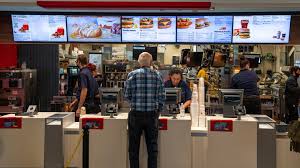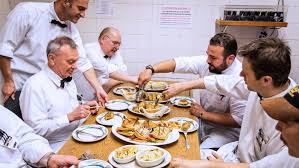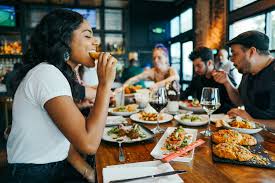A restaurant is a commercial establishment specializing in the preparation and service of quality food to meet customer expectations. The term “restaurant” (from the French word restaurer, meaning “to restore”) first emerged in the 16th century, referring to a rich, highly flavored soup.
The modern concept of a restaurant originated around 1765 when a Parisian soup-seller named Boulanger opened his establishment.
Definition of a Restaurant
A restaurant is a retail establishment that serves prepared food to customers, typically for on-premises dining, though the term also encompasses take-out establishments and food delivery services. Restaurants vary widely in venue types, cuisine styles, and service approaches.
Restaurants are sometimes integrated into larger complexes, such as hotels, where dining amenities cater to residents and non-residents alike, with the primary goal of maximizing revenue for the hotel.
These establishments range from unpretentious lunch spots serving simple, fixed-menu meals at low prices to upscale venues offering specialty cuisine and wines in formal settings. In casual settings, customers typically wear informal clothing, while upscale restaurants may require semi-casual, semi-formal, or, in rare cases, formal attire.
Customers are usually seated at tables, served by waitstaff who take orders and deliver food, and presented with the bill before leaving. In refined establishments, a host, hostess, or maître d’hôtel welcomes and seats guests, supported by staff such as busboys and sommeliers.
Read Also : Health Benefits and Uses of Mustard Seed
Classification of Restaurants

Restaurants can be categorized based on seating availability, service style, formality, and price range. They are generally divided into three groups:
1. Quick Service: Also known as fast-food restaurants, these offer limited menus prepared quickly. They often feature drive-through windows, take-out options, or self-service setups.
2. Mid-Scale: These provide full meals at moderate prices perceived as good value. They may offer full service, buffets, or limited service where customers order at a counter and receive food at their table or self-serve.
3. Upscale: These establishments serve high-quality cuisine at premium prices, offering full service and a sophisticated ambiance.
Types of Restaurants
Restaurants often specialize in specific cuisines or adopt a unifying, sometimes entertaining, theme. For instance, there are seafood, vegetarian, or ethnic restaurants, such as a “Calabar” restaurant.
Restaurants serving local cuisine are typically referred to simply as restaurants, while those offering foreign cuisines are named accordingly, such as Chinese or French restaurants.
Depending on local customs and establishment policies, restaurants may or may not serve alcoholic beverages. Alcohol sale laws often prohibit restaurants from selling alcohol without a meal, as such sales are typically reserved for bars with stricter regulations.
Some restaurants are licensed to serve alcohol (“fully licensed”), while others permit customers to bring their own alcohol.
1. Cafeterias
A cafeteria is a restaurant serving mostly ready-to-eat food arranged behind a counter, with minimal or no table service. Patrons typically take a tray, move along a track, and select food from attendants, pre-portioned plates, or self-service options.
For items like steaks, patrons may order specific preparations (rare, medium, or well-done). Beverages are often self-served from dispensers or ordered from attendants.
Purchases are rung up by a cashier, sometimes priced by weight in self-service cafeterias. Patrons carry trays to tables for dining.
Institutional cafeterias may feature communal tables, while upscale cafeterias offer individual tables, traditional cutlery, crockery, and sometimes servers to assist with trays or clear tables.
Cafeterias provide a wider variety of prepared foods, such as roasts (beef, ham, turkey) carved by a server and other cooked entrées, beyond typical fast-food offerings like hamburgers or fried chicken.
2. Fast-Food Restaurants

Fast-food restaurants, such as Mr. Biggs, Tasty Fried Chicken, or Kentucky Fried Chicken, prioritize speed and low cost. They often lack traditional cutlery or crockery, with customers eating directly from disposable containers using their fingers. The following are common service styles in fast-food restaurants:
1. Customers collect food from a counter, pay, and sit to eat (similar to self-service or cafeteria setups).
2. Sub-varieties include:
i. Collecting ready portions.
ii. Serving oneself from containers.
iii. Being served at the counter.
iv. Paying at a cash desk, receiving a coupon, and exchanging it for food at the counter.
v. Ordering at the counter, with food delivered to the table after preparation; payment may occur at ordering or after eating.
3. Drive-through restaurants without seating, where customers receive food in their cars for off-site consumption.
4. Take-out services offering ready-to-eat hot food in disposable packaging.
3. Casual Restaurants
A casual dining restaurant serves moderately priced food in a relaxed atmosphere. Except for buffet-style setups, these restaurants typically provide table service. They occupy a market segment between fast-food and fine-dining establishments.
4. Fast Casual-Dining Restaurants
Fast casual restaurants resemble fast-food outlets but offer higher-quality food and ambiance without full table service. Prices are higher than fast-food but lower than casual dining. Non-disposable plates and cutlery are typically used.
Counter service with handmade food, often prepared in an open kitchen, is common, and alcohol may be served. Dishes like steak, requiring skilled preparation, are often available, with a limited menu emphasizing preparation options.
Many fast casual restaurants market themselves as health-conscious, offering items like free-range chicken or freshly made salsas.
The food quality is presented as superior to conventional fast food, with some featuring ethnic themes in their menus.
5. Other Restaurant Types
Additional restaurant types can be considered subtypes of fast casual or casual dining:
1. Café: Informal restaurants offering hot meals, made-to-order sandwiches, and full hot breakfasts. Many provide table service and, in some areas, outdoor seating.
2. Coffeehouse: Casual establishments without table service, focusing on coffee and other beverages, with a limited selection of cold foods like pastries or sandwiches. Patrons can relax and socialize for extended periods without pressure to leave.
3. Pub: Bars serving simple food, traditionally focused on drinking but increasingly emphasizing high-quality pub food, as seen in gastro pubs. They offer a large selection of beers and ales on tap.
4. Bistros and Brasseries: A brasserie is a café doubling as a restaurant with single dishes in a relaxed setting. A bistro serves moderately priced, simple meals in an unpretentious environment, often with a European-influenced menu.
5. Family Style: Restaurants with fixed menus and prices, where diners share communal tables and food is served in courses with shared dishes, resembling a family meal. Common in rural areas or theme restaurants, examples include crab houses or BBQ restaurants.
6. BYO (Bring Your Own) Restaurants: Restaurants and bistros without a liquor license, allowing customers to bring their own alcohol.
7. Delicatessens: Restaurants offering foods for immediate consumption, primarily luncheon meats and cheeses, with sandwiches, soups, and salads. Preparation is simple, often involving pre-cooked items.
8. Ethnic Restaurants: These range from quick-service to upscale, specializing in ethnic dishes or multicultural cuisine, such as Asian, Chinese, Indian, or American cuisine.
9. Destination Restaurants: Establishments with strong appeal, drawing customers from beyond their community, such as Michelin Guide 3-star restaurants deemed “worthy of a journey.”
Read Also: Sheep gene insights could help farmers breed healthier animals
Staff Organization in Restaurants

Staff organization focuses on task allocation, responsibility, authority, and relationships within the restaurant.
It introduces concepts like span of control, management levels, and delegation. Positions in the restaurant brigade vary across French, American, and English hotel industries.
Duties and Responsibilities of Restaurant Staff
Catering establishments require various staff roles to operate effectively, with the food and beverage service department typically employing the largest team. Strong leadership and supervision are essential to guide staff and ensure guest satisfaction.
Coordination across outlets is critical for consistent quality service, with teamwork being paramount. Below are the key duties and responsibilities of restaurant staff:
1. Food and Beverage Manager: The head of the food and beverage service department, responsible for administrative and operational oversight. Duties include:
i. Preparing the department budget and ensuring profit margins for each outlet.
ii. Compiling new menus and wine lists in consultation with the chef, based on ingredient availability and trends.
iii. Ensuring quality control through staff training and adherence to standards.
iv. Managing recruitment, promotions, transfers, dismissals, and staff training to meet departmental goals.
The role requires excellent sales, customer service, human resource management, communication, and leadership skills, along with knowledge of products, services, industry regulations, and the local area.
2. Assistant Food and Beverage Manager: Assists the food and beverage manager in daily operations, particularly in large organizations. Responsibilities include:
i. Supporting section heads during busy periods.
ii. Managing an outlet in the absence of its manager.
iii. Setting duty schedules and monitoring outlet managers’ performance.
iv. Running the department independently when needed.
3. Restaurant Manager: Oversees employee relations, food production, sanitation, guest service, and operating profits for a specific outlet (e.g., coffee shop, bar, or specialty restaurant). Duties include:
i. Setting and monitoring service standards.
ii. Handling administrative tasks like duty charts, leave, discipline, and staff promotions.
iii. Training staff through daily briefings.
iv. Managing public relations, guest complaints, and outlet budgets.
v. Planning food festivals and advertising campaigns with the chef and food and beverage manager.
4. Room Service Manager: Manages the room service outlet, ensuring service standards, operational efficiency, and guest satisfaction. Responsibilities include:
i. Monitoring service, billing, duty charts, and absenteeism.
ii. Handling guest complaints about food and service.
iii. Managing sales and expenditure budgets.
iv. Coordinating with order takers, captains, and waiters, and overseeing valet services if offered.
5. Bar Manager: Organizes and controls bar operations, with duties including:
i. Arranging beverage purchases and pricing within budget.
ii. Training and supervising bar staff.
iii. Maintaining stock and financial records.
iv. Ensuring compliance with liquor laws and monitoring customer satisfaction.
6. Banquet Manager: Supervises banquet operations, coordinating setup, service, and breakdown according to hotel standards. Responsibilities include:
i. Managing bookings, menus, and budgets in coordination with the chef.
ii. Supervising banquet sales assistants, captains, and waiters.
iii. Maintaining inventory of banquet equipment and balancing revenue and expenditure.
7. Other Staff Designations:
i. Senior Captain or Maître d’Hôtel: Oversees operations, prepares duty charts, manages mise-en-place, and ensures the outlet is ready for service. Receives guests and steps in for other staff as needed.
ii. Reception Head Waiter: Manages bookings, reserves tables, and greets and seats guests.
iii. Captain/Chef de Rang: Supervises a section (4–5 tables or 20–24 covers), takes orders, performs specialized service (e.g., gueridon work), and ensures efficient staff performance.
iv. Waiters/Commis de Rang/Server: Serve food and beverages, support the captain, and coordinate with other staff. Must be knowledgeable about menu items.
v. Trainee/Commis de Barrasseur: Assists waiters with mise-en-place, fetching orders, and clearing stations, often a learner role for those entering food service.
vi. Wine Waiter/Sommelier: Handles wine and alcoholic beverage orders, advising on pairings and ensuring compliance with licensing laws.
vii. Room Service Waiters/Chef d’Étage: Deliver food and beverages to guest rooms, coordinating with kitchen and bar staff.
viii. Carver/Trancheur: Manages the carving trolley and serves portions with appropriate accompaniments.
ix. Floor Service Staff/Floor Waiter: Handles service for an entire floor or multiple rooms, delivering meals via lifts in heated trolleys.
x. Lounge Staff/Chef de Sale: Manages lounge service, including morning coffee, afternoon teas, and aperitifs, maintaining cleanliness and presentation.
xi. Cocktail Bar Staff: Prepares and serves cocktails, requiring knowledge of drinks and licensing laws.
xii. Buffet Assistant/Buffet Chef/Chef de Buffet: Oversees buffet presentation, carving, portioning, and service.
xiii. Counter Assistants: Stock counters and serve or portion food in cafeterias, sometimes cooking call-order items.
xiv. Table Clearers: Clear tables and trolleys, ensuring proper stacking of crockery, glassware, and cutlery.
This article provides an overview of the diverse types of restaurants and the critical roles and responsibilities of personnel in the food service industry, emphasizing the importance of organization and teamwork in delivering exceptional guest experiences.
Do you have any questions, suggestions, or contributions? If so, please feel free to use the comment box below to share your thoughts. We also encourage you to kindly share this information with others who might benefit from it. Since we can’t reach everyone at once, we truly appreciate your help in spreading the word. Thank you so much for your support and for sharing!

